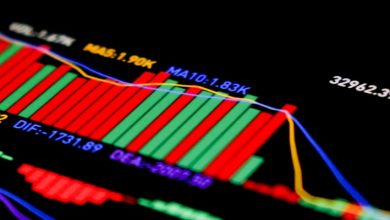Understanding Market Liquidity and Its Importance

- What is market liquidity and why is it important?
- The relationship between market liquidity and trading volume
- Factors influencing market liquidity
- Measuring market liquidity: key indicators to consider
- The impact of market liquidity on asset prices
- Strategies for managing liquidity risk in the market
What is market liquidity and why is it important?
Market liquidity refers to the ease with which an asset can be bought or sold in the market without causing a significant change in its price. In simpler terms, it is the degree to which an asset can be quickly converted into cash. Liquidity is crucial for the smooth functioning of financial markets as it ensures that there are enough buyers and sellers in the market at any given time.
High market liquidity means that there is a high volume of trading activity happening in the market, making it easier for investors to enter or exit positions without causing drastic price movements. On the other hand, low market liquidity can lead to price volatility and wider bid-ask spreads, making it more difficult and costly for investors to trade in certain assets.
Market liquidity is important for several reasons. Firstly, it provides investors with the ability to quickly buy or sell assets at fair prices, reducing the risk of being stuck in an illiquid investment. Secondly, it helps to ensure price stability in the market by preventing large price swings due to sudden imbalances in supply and demand. Lastly, liquidity is essential for the overall efficiency of financial markets, as it allows capital to flow smoothly between investors and companies.
The relationship between market liquidity and trading volume
The relationship between market liquidity and trading volume is a crucial concept to understand when it comes to analyzing financial markets. Market liquidity refers to how easily an asset can be bought or sold without causing a significant change in its price. Trading volume, on the other hand, is the total number of shares or contracts traded in a specific period.
In general, there is a positive correlation between market liquidity and trading volume. When liquidity is high, it is easier for traders to enter and exit positions, leading to increased trading volume. On the other hand, when liquidity is low, trading volume tends to decrease as traders may find it more challenging to buy or sell assets without impacting prices significantly.
High market liquidity and trading volume can be indicative of a healthy and efficient market. It provides traders with more opportunities to execute their trades quickly and at fair prices. Additionally, high liquidity and trading volume can help reduce the bid-ask spread, which is the difference between the price at which a seller is willing to sell and a buyer is willing to pay.
It is essential for investors and traders to monitor market liquidity and trading volume to make informed decisions. Understanding how these two factors interact can help traders anticipate market movements and adjust their strategies accordingly. By paying attention to market liquidity and trading volume, traders can better navigate the financial markets and improve their chances of success.
Factors influencing market liquidity
Factors influencing market liquidity can vary depending on various external and internal factors that affect the supply and demand of assets. These factors play a crucial role in determining how easily assets can be bought or sold in the market.
One factor that influences market liquidity is the overall economic conditions. In times of economic uncertainty or recession, investors may be hesitant to buy or sell assets, leading to lower liquidity in the market. On the other hand, during periods of economic growth, investors may be more willing to engage in trading activities, resulting in higher liquidity.
Another factor that can impact market liquidity is the level of market participants. The more buyers and sellers there are in the market, the easier it is to buy or sell assets quickly without significantly impacting their prices. Conversely, if there are fewer market participants, liquidity may be lower, making it harder to execute trades at desired prices.
Additionally, the type of assets being traded can also influence market liquidity. Highly liquid assets such as major currencies or blue-chip stocks tend to have higher liquidity compared to less liquid assets like small-cap stocks or illiquid bonds. Factors such as the size of the market, trading volume, and ease of trading can all affect the liquidity of an asset.
Furthermore, external events such as geopolitical tensions, natural disasters, or regulatory changes can impact market liquidity by creating uncertainty and causing market participants to adjust their trading strategies. These events can lead to increased volatility and decreased liquidity in the market, making it more challenging to buy or sell assets at desired prices.
Overall, understanding the factors that influence market liquidity is crucial for investors and traders to navigate the financial markets effectively. By staying informed about economic conditions, market participants, asset types, and external events, market participants can make more informed decisions and manage their risks more effectively in a liquid market environment.
Measuring market liquidity: key indicators to consider
When measuring market liquidity, it is essential to consider key indicators that can provide valuable insights into the overall health and efficiency of a market. These indicators can help investors and analysts gauge the ease with which assets can be bought or sold without significantly impacting their prices. By monitoring these indicators, market participants can make more informed decisions and manage their risk exposure effectively.
- 1. Bid-ask spread: The bid-ask spread is a key indicator of market liquidity that represents the difference between the highest price a buyer is willing to pay for an asset (bid) and the lowest price a seller is willing to accept (ask). A narrow bid-ask spread typically indicates a liquid market, while a wide spread may suggest lower liquidity.
- 2. Trading volume: Trading volume refers to the total number of shares or contracts traded in a market during a specific period. Higher trading volumes often indicate greater liquidity, as there are more buyers and sellers actively participating in the market.
- 3. Market depth: Market depth measures the quantity of buy and sell orders at various price levels beyond the best bid and ask prices. Deeper market depth generally indicates higher liquidity, as there is a larger pool of orders available to match trades.
- 4. Price impact: Price impact assesses how a trade order affects the price of an asset. In liquid markets, large trade orders typically have minimal price impact, whereas in illiquid markets, large orders can significantly move prices.
- 5. Turnover ratio: The turnover ratio calculates the value of all trades in a market relative to the total market capitalization. A high turnover ratio suggests higher liquidity, as assets are being actively traded and exchanged among investors.
By considering these key indicators, market participants can gain a better understanding of market liquidity and its implications for trading and investing. Monitoring these indicators regularly can help investors identify potential risks and opportunities, ultimately leading to more informed decision-making and improved portfolio management.
The impact of market liquidity on asset prices
Market liquidity plays a crucial role in determining asset prices. When there is high liquidity in the market, it means that assets can be easily bought or sold without significantly impacting their prices. On the other hand, low market liquidity can lead to wider bid-ask spreads and increased price volatility.
One of the key factors that influence the impact of market liquidity on asset prices is the level of trading activity. Higher trading volumes typically indicate greater liquidity, as there are more buyers and sellers in the market. This can help ensure that asset prices more accurately reflect their true value.
Additionally, the presence of market makers can also have a significant impact on liquidity and asset prices. Market makers are individuals or firms that stand ready to buy or sell assets at all times, providing liquidity to the market. Their presence can help reduce price fluctuations and ensure that assets can be traded more easily.
Strategies for managing liquidity risk in the market
When it comes to managing liquidity risk in the market, there are several strategies that investors and financial institutions can employ to mitigate potential challenges. By taking proactive measures, market participants can ensure they have the necessary liquidity to meet their obligations and take advantage of investment opportunities.
- Diversification: One effective strategy for managing liquidity risk is diversifying investments across different asset classes and markets. By spreading investments out, investors can reduce their exposure to any single market or security, helping to mitigate the impact of liquidity fluctuations.
- Monitoring: Regularly monitoring market conditions and liquidity metrics is crucial for identifying potential risks and opportunities. By staying informed about changes in market liquidity, investors can adjust their strategies accordingly to maintain optimal liquidity levels.
- Stress testing: Conducting stress tests on investment portfolios can help assess how they would perform under adverse market conditions. By simulating different scenarios, investors can identify potential liquidity constraints and take preemptive measures to address them.
- Establishing lines of credit: Having access to lines of credit or other sources of liquidity can provide investors with a safety net during periods of market stress. By securing additional funding options in advance, investors can avoid being forced to sell assets at unfavorable prices to meet liquidity needs.
Overall, managing liquidity risk in the market requires a proactive and strategic approach. By implementing these strategies and staying vigilant about market conditions, investors can better navigate potential liquidity challenges and enhance their overall financial resilience.



